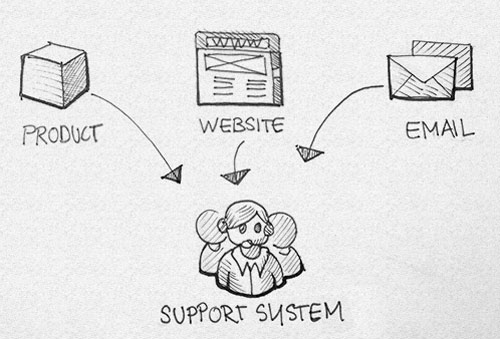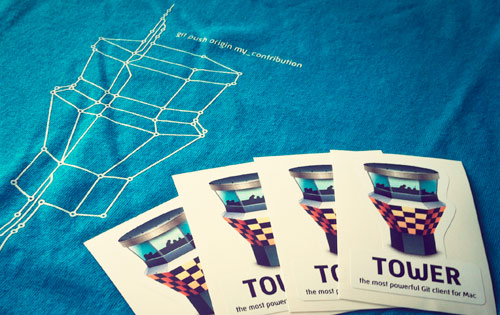Be Prepared
By now you should have a list of 20-50 early adopters that are waiting to test your product. Before you send out your first build, make sure that you are ready for what's coming next: questions, feedback, bug reports, and hopefully more users.
At this stage of product development, feedback from users is your most important metric. Therefore, you should have everything in place to collect and process it accordingly. There is a wide range of tools and services available that help you with customer support and ticketing. You could of course just start by handling all of this via email. However, from the experience with our product Tower we recommend to start with the right setup from the beginning.
This will save you many headaches later on. It will not only ensure that your users have a great customer support experience. You will also be able to learn as much as possible from real users while still having the time and resources to further develop your product.
It was important for us that all the messages we receive - no matter if via email, the support form on our website, or our in-app reporting tool - end up in a central hub.

You need to:
- easily process these messages
- reply to them quickly
- convert them into tickets (if necessary)
- and assign them to coworkers
Besides bug reports you will also receive many feature requests. Make sure to collect, filter, and group them. This will not only give you valuable insights on how many users really request a feature. It will also give you a feeling on how your internal roadmap matches their needs and expectations.
Keep it Personal
Once you send out your first version and receive the first responses, try to build a personal relationship with your early users. Listen carefully and take the time to address each message. Avoid automated responses and answer questions immediately.
Support is always more than that: it's feedback, learning, customer development, marketing, and - at a later stage - also sales. It's your chance to turn your first users into loyal customers. Be patient and invest your time!
We put a lot of effort into this and our users noticed. It gives them an extra incentive to use your product, give you feedback and recommend it to their network. They will know that you care about them and that they are part of something special.
Scale Slowly
While it depends on the product or service you offer, it can be extremely helpful to limit the access to your beta at first and scale as your resources will allow. At the beginning you will want to control the size of your beta for several reasons: your product will still be buggy and important features might still be missing. If you open up your beta too quickly, users will report the same bug over and over again. Your learning will suffer under too much feedback. Start small, ship often and invite more users step by step.
In order to control the number of early beta testers, we started with an invite-only private beta. With a great product you will automatically receive more requests from others who want to join. Even if this is the case keep looking for opinion leaders and early adopters during the whole beta period and invite them to test your product. Make sure that you always have enough candidates on your list, so that you can scale your user base when needed.

While being in private beta, point people that hear about your product and show interest to a designated landing page. Take the time to design a great looking site that gets people excited. Give them a sneak peek and start collecting email addresses by using a service like Mailchimp. This newsletter list will be very handy once you are ready to open up your beta - and also for your upcoming launch.
Besides the newsletter list you also want to set up your social media accounts. Focus on the channels that your target group uses the most. Each additional account will need your attention. Only set up accounts that you will use and maintain.
Hello World
Before you invite the masses, make sure you are prepared. You want to give your 10,000th user the same great experience as your very first users. With everything in place it's time to let the world know about your public beta.
Now your research for opinion leaders will pay off. With their help and the rest of your private beta testers as well as your newsletter list, word will spread quickly within your target group.
Due to the support of our early users we were able to quickly grow to 2,500 Twitter followers, 6,000 newsletter sign ups and more than 40,000 beta tester. Keep your users engaged by shipping new versions regularly and keep them updated about your progress while approaching version 1.0.

Once you're getting closer to launch, take the time to thank your beta testers. You can differentiate depending on their effort. All the testers from our private beta received free licenses while all public beta testers received a discount when we launched. Some early users were so supportive - and many are still today - that we came up with a special surprise for them: we designed a custom T-shirt and shipped it with stickers and a personal thank you note to around 50 users around the world. They will remember this gesture and their support can give you a big boost on your launch day.
In summary, we recommend that you:
- implement a workflow to handle support and feedback from the beginning
- build a personal relationship with early users
- collect email addresses and grow your follower base
- start with a small beta and scale slowly
- ship often and keep your users engaged
- thank them for their support
- launch your 1.0 with the help of your user base
When you invest time and thought in the planning of your beta, your product will not only reach version 1.0 quicker. You will also have a fantastic basis for a successful launch.
In the third and last part of this series we'll talk about the actual launch. We will share our learnings and tips to make your launch as successful as possible.
